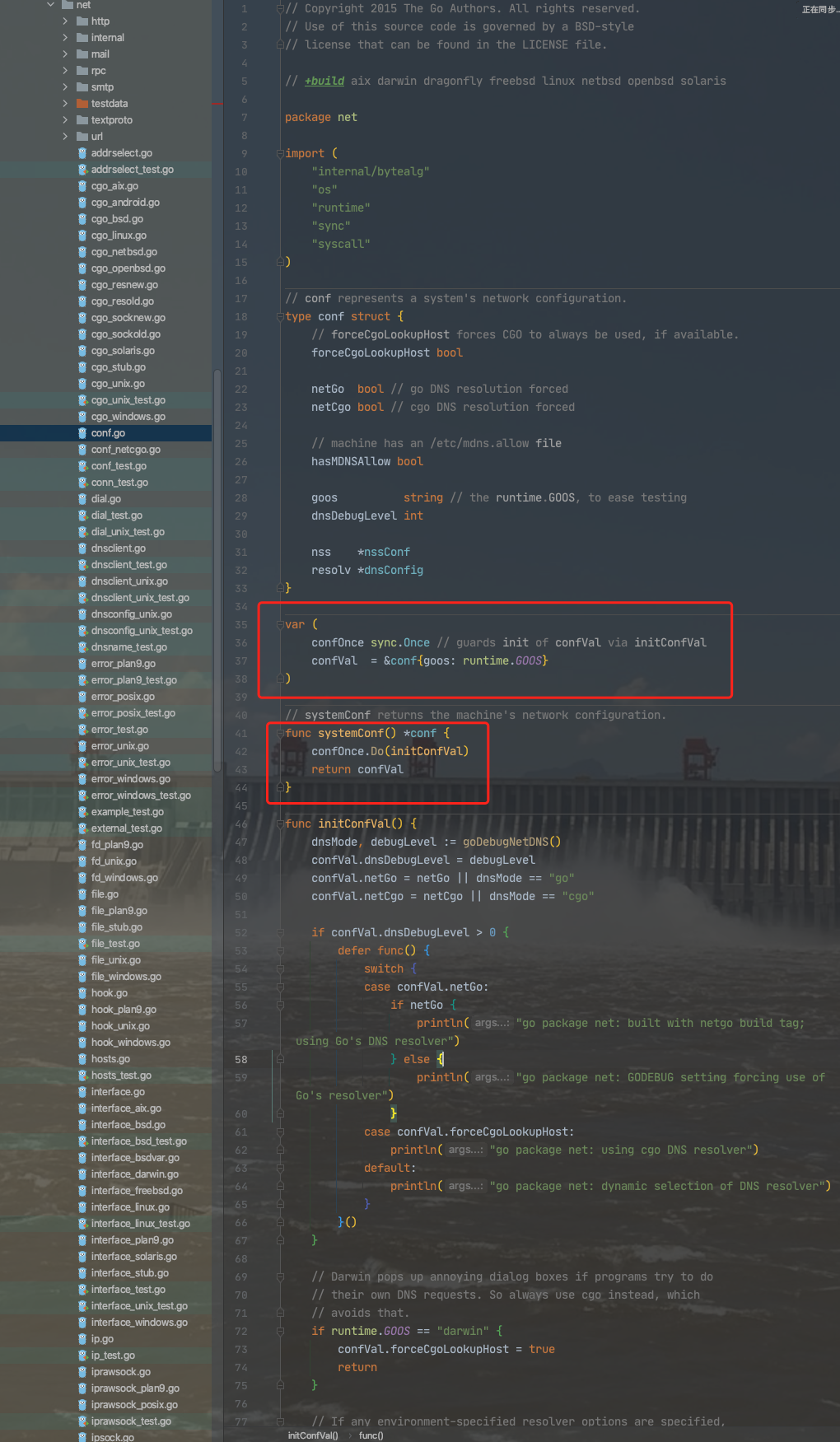初入门径
sync.Once提供了保证某个操作只被执行一次的功能,其最常应用于单例模式之下,例如初始化系统配置、保持数据库唯一连接,以及并发访问只需要初始化一次的共享资源。
单例模式有懒汉模式和饿汉模式两种
饿汉模式 顾名思义就是比较饥饿,所以一上来(服务启动时)就初始化。
懒汉模式 顾名思义就是偷懒,在获取实例的时候在进行初始化,但懒汉模式会有并发问题:有可能多个 goruntine 同时获取 对象都是 nil ,然后都开始创建了实例,就不满足单例模式了。解决办法是加锁
sync.Once就是懒汉模式
Go并发编程 — sync.Once[1]
package main
import (
"fmt"
"sync"
)
func main() {
var once sync.Once
fun1 := func() {
fmt.Println("一只老虎")
}
once.Do(fun1)
fun2 := func() {
fmt.Println("两只老虎")
}
once.Do(fun2)
}
输出为:
一只老虎
并发调用 Do()
package main
import (
"fmt"
"sync"
"time"
)
func main() {
var once sync.Once
for i := 0; i < 5; i++ {
go func(i int) {
fun1 := func() {
fmt.Printf("i:=%d\n", i)
}
once.Do(fun1)
}(i)
}
// 为防止主goroutine直接运行完,什么都看不到
time.Sleep(50 * time.Millisecond)
}
在上面这段代码里,开启了5个并发的 goroutine ,不管执行多少次, 始终只打印一次. 至于 i 是多少,就看先执行的是哪个 g 了。
Once 保证只有第一次调用 Do() 方法时, 传递的 f (无参数无返回值的函数) 才会执行,并且之后不管调用的参数是否改变了,也不管f执行时是否发生了panic,之后都不再执行。
这段是官方Demo:
package main
import (
"fmt"
"sync"
)
func main() {
var once sync.Once
onceBody := func() {
fmt.Println("Only once")
}
done := make(chan bool)
for i := 0; i < 10; i++ {
go func() {
once.Do(onceBody)
done <- true
}()
}
for i := 0; i < 10; i++ {
<-done
}
}
// 结果只打印一次:only once
源码实现
其代码实现很简洁, 从头到尾加注释不超过 70 行. 对外暴露了一个唯一接口 Do(f func()), 使用起来也很简单,可以多次调用,但是只有第一次调用Do方法时f参数才会执行,这里的f是一个无参数无返回值的函数。
点击查看 sync.Once源码:
// Copyright 2009 The Go Authors. All rights reserved.
// Use of this source code is governed by a BSD-style
// license that can be found in the LICENSE file.
package sync
import (
"sync/atomic"
)
// Once is an object that will perform exactly one action.
type Once struct {
// done indicates whether the action has been performed.
// It is first in the struct because it is used in the hot path.
// The hot path is inlined at every call site.
// Placing done first allows more compact instructions on some architectures (amd64/x86),
// and fewer instructions (to calculate offset) on other architectures.
// done用来表示当前的操作是否已经被执行, 0表示还没有执行过, 1表示已经执行
// done属性放在结构体的第一位,是因为它在hot path中使用
// hot path在每个调用点会被内联
// 将done放在结构体首位,像amd64/386等架构上可以允许更多的压缩指令,且在其他架构上更少的指令去计算偏移量
done uint32
m Mutex
}
// Do calls the function f if and only if Do is being called for the
// first time for this instance of Once. In other words, given
// var once Once
// if once.Do(f) is called multiple times, only the first call will invoke f,
// even if f has a different value in each invocation. A new instance of
// Once is required for each function to execute.
//
// Do is intended for initialization that must be run exactly once. Since f
// is niladic, it may be necessary to use a function literal to capture the
// arguments to a function to be invoked by Do:
// config.once.Do(func() { config.init(filename) })
//
// Because no call to Do returns until the one call to f returns, if f causes
// Do to be called, it will deadlock.
//
// If f panics, Do considers it to have returned; future calls of Do return
// without calling f.
//
// Do的作用主要是针对初始化且有且只能执行一次的场景。因为Do直到f返回才返回,`
// 所以如果f内再调用Do则会导致死锁
// 如果f执行过程中panic了 那么Do任务f已经执行完毕 未来再次调用不会再执行f
func (o *Once) Do(f func()) {
// Note: Here is an incorrect implementation of Do:
//
// if atomic.CompareAndSwapUint32(&o.done, 0, 1) {
// f()
// }
//
// Do guarantees that when it returns, f has finished.
// This implementation would not implement that guarantee:
// given two simultaneous calls, the winner of the cas would
// call f, and the second would return immediately, without
// waiting for the first's call to f to complete.
// This is why the slow path falls back to a mutex, and why
// the atomic.StoreUint32 must be delayed until after f returns.
if atomic.LoadUint32(&o.done) == 0 {
// Outlined slow-path to allow inlining of the fast-path.
// 原子获取 done 的值,判断 done 值是否为 0,如果为 0 就调用 doSlow 方法,进行二次检查。
// 可能会存在并发 进入slow-path
o.doSlow(f)
}
}
func (o *Once) doSlow(f func()) {
// 二次检查时,持有互斥锁,保证只有一个 goroutine 执行。
o.m.Lock()
defer o.m.Unlock()
if o.done == 0 { //二次判断f是否已经被执行
// 二次检查,如果 done 的值仍为 0,则认为是第一次执行,执行参数 f,并将 done 的值设置为 1。
//即使此时有多个 goroutine 同时进入了 doSlow 方法,因为双检查的机制,后续的 goroutine 会看到 o.done 的值为 1,也不会再次执行 f
defer atomic.StoreUint32(&o.done, 1)
f()
}
}
Once 结构体中包含两个字段, 分别是 uint32 类型的 done 和 Mutex 类型的 m.
Once 实现了两个方法, 分别是 Do 和 doSlow。其中 doSlow 是一个非可导出方法,只能在内部被 Do 方法调用.
Done 方法先原子获取 done 的值,如果 done 的值为 0,则调用 doSlow 方法进行二次检查,二次检查时,持有互斥锁,保证只有一个 goroutine 执行操作.如果二次检查的结果为 0,则认为是第一次执行,程序执行函数类型的参数 f,然后将 done 的值设置为 1.
注意事项
package main
import (
"fmt"
"sync"
)
func main() {
panicDo()
//nestedDo()
nestedDo2()
}
func panicDo() {
once := &sync.Once{}
defer func() {
if err := recover(); err != nil {
once.Do(func() {
fmt.Println("run in recover")
})
}
}()
once.Do(func() {
panic("panic i=0")
})
}
func nestedDo() {
once := &sync.Once{}
once.Do(func() {
once.Do(func() {
fmt.Println("test nestedDo")
})
})
}
func nestedDo2() {
once1 := &sync.Once{}
once2 := &sync.Once{}
once1.Do(func() {
once2.Do(func() {
fmt.Println("test nestedDo")
})
})
}
详解并发编程之sync.Once的实现(附上三道面试题)[2]
(1). sync.Once()方法中传入的函数发生了panic,重复传入还会执行吗?
执行panicDo方法,不会打印任何东西. sync.Once.Do 方法中传入的函数只会被执行一次,哪怕函数中发生了 panic;
(2). sync.Once()方法传入的函数中再次调用sync.Once()方法会有什么问题吗?
会发生死锁! 执行nestedDo方法,会报 fatal error: all goroutines are asleep - deadlock! 根据源码实现,可知在第二个do方法会一直等doshow()中锁的释放导致发生了死锁;
(3). 执行nestedDo2,会输出什么?
会打印出 test nestedDo. once1,once2是两个对象,互不影响. 所以sync.Once是使方法只执行一次对象的实现。
官方库或知名项目中的使用
net包 系统的网络配置 就是存放在一个变量里,用sync.Once控制读写

当且仅当第一次读某个变量时,进行初始化(写操作)
变量被初始化过程中,所有读都被阻塞(读操作;当变量初始化完成后,读操作继续进行
变量仅初始化一次,初始化完成后驻留在内存里
Golang package sync 剖析(一): sync.Once[3]
参考:
你真的了解 sync.Once 吗[4]
深入源码分析golang之sync.Once[5]
参考资料
Go并发编程 — sync.Once: https://juejin.cn/post/7093394883875962894
[2]详解并发编程之sync.Once的实现(附上三道面试题): https://segmentfault.com/a/1190000040038329
[3]Golang package sync 剖析(一): sync.Once: https://segmentfault.com/a/1190000040044135
[4]你真的了解 sync.Once 吗: https://segmentfault.com/a/1190000040042235
[5]深入源码分析golang之sync.Once: https://segmentfault.com/a/1190000040043353
本文由 mdnice 多平台发布